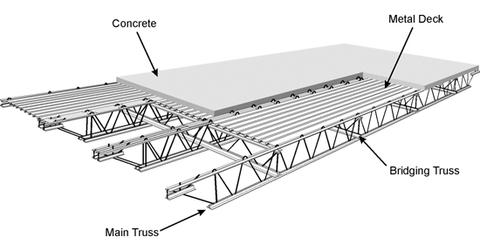Spurred by
@Oystein, inspired by
@Henkka, and challenged by
@Mendel, I'd like to make the argument for why it's hard to believe that fire alone (or a small amount of explosives at the top) could have brought down the towers.
Imagine two very large box columns, one inside the other. The outer column represents the perimeter shell of the WTC towers, the other represents the core. Make the shell 3" thick at the base (tappering upwards) and the core 6" thick. Make the perimeter a 200' square and the core an 80' square.
Bolt them directly to the bedrock.
These columns will have their own Euler self-buckling limit individually, but they can be strengthened (as the towers were) by connecting the perimeter to the core at regular intervals with trusses. So imagine putting eight trusses every 10' feet, connecting the perimeter to the core, each corner to each corner and each face to each face.
Next, we're going to have to load those floors. Imagine a square donut concrete slab resting on those eight trusses at every story.
What we need, in the first instance, is to determine a height and load (per floor) for this structure that would allow it to stand up in hurricane force winds. (This is not a "scaled down" model; it's just a very simplified one. Its actual dimensions are roughly similar to the WTC towers.)
Next we need to tweak it so that sustained fires (for a few hours) on three floors would cause the trusses to sag sufficiently to pull in the outer shell, initiating collapse.
Finally, we need this to cause the total collapse of the building. I realize this is just a constrainted version of the Hoffman challenge, which has already been dicussed (
see this thread), and I'm not asking you to solve it (which would require math that, as I understand it, none of us are capable of doing).
What I'm asking you to understand is that the difficulty you (hopefully) have imagining this structure collapsing totally to the ground by fire (given that it wouldn't collapse by hurricane or earthquake) is the difficulty that I (and, I presume,
@Henkka) have understanding how fires alone could have brought down the WTC.
I cannot imagine there's a height / load / connection strength distribution that makes it both strong enough under ordinary circumstances to stand and weak enough when on fire to fail. And I really do believe I'm providing the basic design concept of the WTC towers. This is how it is described by people like Guy Nordenson in a video that I've mentioned before where he talks about the design of the outer shell of the WTC in some detail. The relevant portion is 5 minutes (from where I've cued it up). At 17:56 he says:
And by people like Leslie Robertson (I think that's who it is) in this video, who describes the shell as a "box":
Finally, I promised Oystein I would find the place where Uwe Starossek uses a similar thought experiment to present a "design concept" using a massive tube (rather than a system of columns). I believe he used it in the book
Progressive Collapse of Structures, but I don't have those pages on hand. Instead, I found it in a journal article he published in
Structural Engineering International 18(3), 2008, called "Avoiding Disproportionate Collapse of Tall Buildings". Here's the key passage:

Source:
https://www.tandfonline.com/doi/abs/10.2749/101686608785096577
I'm not sure it's what you're looking for, but that's the argument for my "incredulity". There are plenty of ways to poke holes in it. And it is my sincere hope that you do poke enough holes in it to make it collapse in a manner that is comparable to ROOSD. I have not been able to do it.
The obvious strategy is to put windows in the shell. But converting the outer shell faces from single plates of 3" (at the base) steel into 60 box columns with 3" walls connected with spandrel plates seems to me to produce a structure of (at least) the same strength (which was, I believe, the point).
I also don't see how just adding more (and weaker) trusses would change anything substantially. And I don't think the problem changes if we imagine the weakening at the top to be brought about by well-placed charges on the initiating floors. But I'm all ears.

